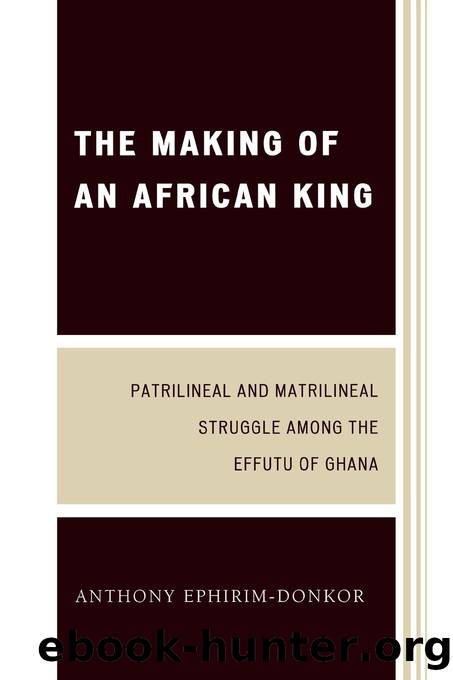The Making of an African King by Ephirim-Donkor Anthony;

Author:Ephirim-Donkor, Anthony;
Language: eng
Format: epub
Publisher: UPA
Published: 2009-08-15T00:00:00+00:00
At Anomabu, where King Ghartey IV resided before becoming king, he was made treasurer and âMagistrate for the Town Courtâ by King Afedzie and his chiefs and elders. This was in recognition of his charitable contributions and invaluable services to that community. In 1861, upon his return from a business trip to England, King Ghartey created a branch of the Temperance Society of Sparkbrook, England. The Anomabu Temperance Societyâs Band of Hope, according to Sampson ârendered songs at times during services in church and funerals, long before the modern singing band was introduced by the late Rev. A. W. Parker of the Wesleyan Mission.â King Ghartey also financed the construction of a huge water tank for the members of the society for 150 pounds, which became Anomabuâs only source of water.
Notwithstanding, King Ghartey IV had his share of political problems too. Since the formation of the militias to the present day, the two groups had engaged in hostilities periodically. From all the accounts, the Dentsewo militia was always the first to start hostilities. Whatever the reason, the Dentsewo militia had never accepted their subordinated status vis-Ã -vis the Tuawo and intent on fighting their way to superiority. In this context, another fight broke out between the Tuawo and the Dentsewo militias during the reign of Ghartey IV. What was strange about this particular hostility was what happened afterwards. Sampson describes:
One of the awful experiences in the life of King Ghartey was when in 1885 a riot took place between the two companies in WinnebaâNo. 1 and No. 2 Companies (Tuafu and Dentsiful)âwhich led to a prosecution at Accra on a capital charge, and finally a condemnation to death of a good many of those who took part in the riot. The petition, which was submitted by King Ghartey on their behalf, failed to achieve anything. But a curious fact happened, which remains a puzzle up to the present day; and that was the deaths which occurred during the same year in which the people were condemned, of all the Europeans who had anything to do with the case, namely, the Queenâs Advocate who prosecuted, the Chief Justice who sentenced the people, the Sheriff who delivered them for execution, the Engineer who fixed the gallows, and Governor W. A. Young himself, who signed the death warrantâall followed one after the other in the course of the year, the last being the gaoler (Trant), who did the last act of killing.19
Download
This site does not store any files on its server. We only index and link to content provided by other sites. Please contact the content providers to delete copyright contents if any and email us, we'll remove relevant links or contents immediately.
Phoenicians among Others: Why Migrants Mattered in the Ancient Mediterranean by Denise Demetriou(577)
Verus Israel: Study of the Relations Between Christians and Jews in the Roman Empire, AD 135-425 by Marcel Simon(576)
Caesar Rules: The Emperor in the Changing Roman World (c. 50 BC â AD 565) by Olivier Hekster(558)
Europe, Strategy and Armed Forces by Sven Biscop Jo Coelmont(504)
american english file 1 student book 3rd edition by Unknown(481)
Give Me Liberty, Seventh Edition by Foner Eric & DuVal Kathleen & McGirr Lisa(469)
Banned in the U.S.A. : A Reference Guide to Book Censorship in Schools and Public Libraries by Herbert N. Foerstel(468)
The Roman World 44 BC-AD 180 by Martin Goodman(458)
Reading Colonial Japan by Mason Michele;Lee Helen;(457)
Basic japanese A grammar and workbook by Unknown(456)
DS001-THE MAN OF BRONZE by J.R.A(443)
The Dangerous Life and Ideas of Diogenes the Cynic by Jean-Manuel Roubineau(440)
Introducing Christian Ethics by Samuel Wells and Ben Quash with Rebekah Eklund(433)
Imperial Rome AD 193 - 284 by Ando Clifford(432)
The Oxford History of World War II by Richard Overy(432)
Literary Mathematics by Michael Gavin;(392)
Language Hacking Mandarin by Benny Lewis & Dr. Licheng Gu(380)
Catiline by Henrik Ibsen--Delphi Classics (Illustrated) by Henrik Ibsen(369)
How to Reach the 9.0 in IELTS Academic Reading by IELTS Medical(358)
